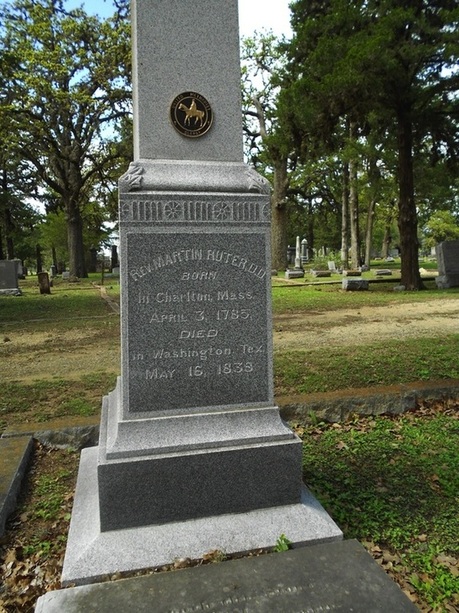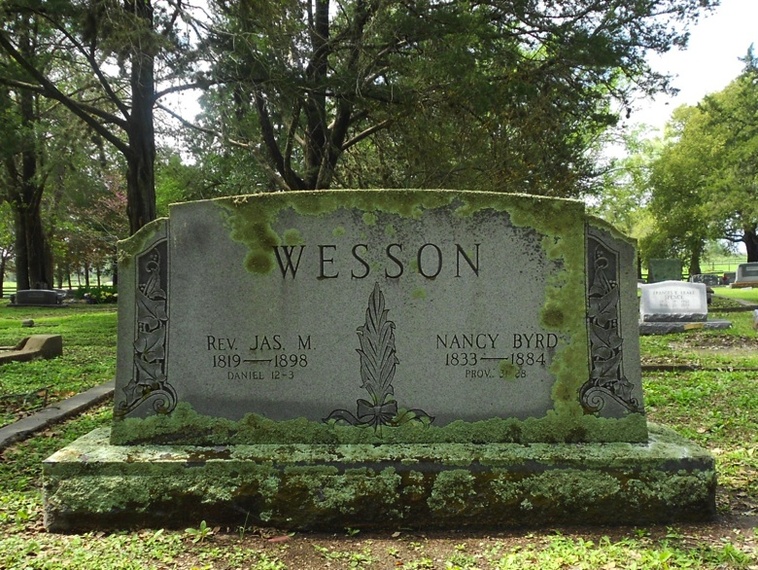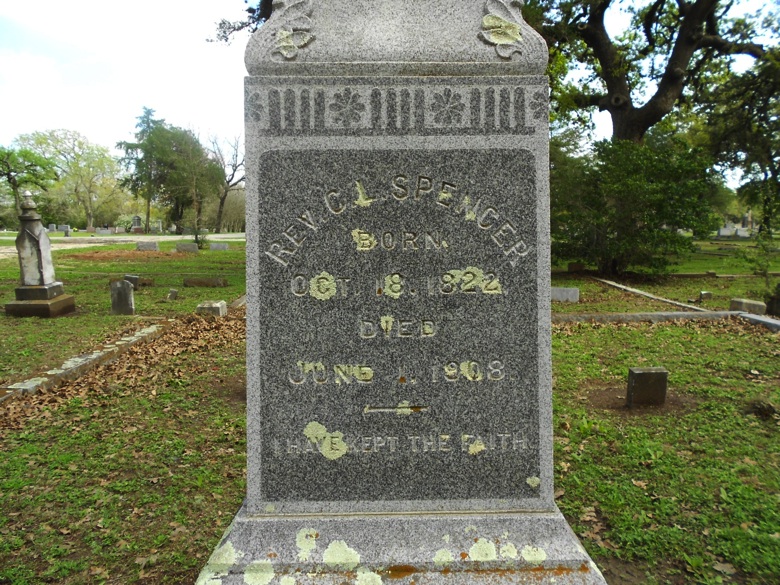|
Text and photos by Betty Dunn
In Navasota’s Oakland Cemetery are the mortal remains of three Methodist clergymen who were figures in the history of this Trans Brazos region. They are namely Rev. Martin Ruter, Rev. James Wesson and Rev. C. L. Spencer. The three impacted early Texas from 1837 to 1908. Rev. Ruter, in November of 1837, president of Berea College in Kentucky, rode horseback into the new Republic of Texas as a preacher and superintendent of Methodist Missions. Traveling and preaching as an itinerant Methodist minister to new settlers, Dr. Ruter concluded that the best way to preach the word of God in this new territory was to establish a Christian school. Dr. Ruter planted the idea of his college with other Methodist preachers. Though Dr. Ruter was stricken with fever and died at Washington-on-the-Brazos the following year in May of 1838, plans for the college progressed when ten Methodists minister banded together to purchase a tract of land establishing Rutersville College at a village named in Rev. Ruter’s honor. (To find Rutersville, drive along Texas Highway 159 about six miles northeast of LaGrange in Fayette County. Watch closely as this once thriving community of nearly a thousand German and Czech immigrants today boasts only a handful of people and a couple business establishments.) The Republic of Texas 4th Congress chartered Rutersville College in January 1840 as the Republic’s first institute of higher education granting four leagues of land from which funds of sales were to be used to develop the school. Eventually facilities included a two-story wooden main building featuring double front doors, a wide chimney at the opposite end and a bell. The girl’s academy building was built of limestone providing a study hall-recitation room, a chapel and a dining room. The president’s two-story home was also a girl’s dormitory. Fifty-two acres were devoted for the male department and twenty-four acres for the female department. The coeducational school, located on a hill overlooking the rolling Colorado River Valley, opened within months with sixty-three students. These college students often played hooky, but it wasn’t for fun. They fought Indians raiding neighboring Texas settlers. Rev. Chauncey Richardson was the president of Rutersville College from its opening until 1845. It was after his departure that the college began to fail. Richardson died in 1852 in Fort Bend County at the age of 49. He was buried on the hilltop site of Rutersville College where a monument now marks his grave. In the late 1840’s into the 1850’s, due to the Mexican War, local Indian troubles, as well as the opening of nearby rival institutions, enrollment began declining. In 1856 the college consolidated with the Texas Military Institute in Galveston and the Texas Monumental Committee at LaGrange to form the Texas Monumental and Military Institute. In 1883 the Rutersville campus was acquired by the Southern German Conference of the Methodist Church. It then operated as a conference school until 1894 when it closed. The campus buildings were eventually razed. When Rev. Ruter died in 1838 he was buried in a Washington-on-the-Brazos cemetery that later was abandoned. Rev. C. L. Spencer, a Methodist minister serving in the Navasota area, stepped up and had Rev. Ruter’s remains removed from Washington and, on June 14, 1899, reburied in a gravesite plot at Oakland Cemetery that would later, in 1908, become his own gravesite. In 1930 it would also become his wife Mary’s gravesite. Their 5 year old daughter, Mary Lynn, born in February 1870 and died in July 1875, is also buried in this plot. According to census records, both Rev. and Mrs. Spencer had been born in Missouri. Little else has been learned of the Spencers. ---------------------------------------------------------------------------- Rev. James Middleton Wesson, a circuit rider for the Methodist Church in Grimes County and the Trans-Brazos region, was born in England in 1819 and died in 1898. Rev. Wesson is often mentioned in local Methodist Church history including that of Plantersville, Texas as the co-founder of a ministry among local freedmen shortly following the Civil War. In the Wixon Community of Brazos County a few miles northeast of Bryan, Wesson established a church called the Wesson Chapel. It is known to have been in existence in early 1882 and still survives. A cemetery is located there known as the Wesson Cemetery in which there are at least 35 burials as listed on www.findagrave.com. Rev. Wesson, in the early 1860s, married Nancy Byrd. She was the daughter of Macajah and Hanna Byrd of Washington on the Brazos. The Byrds were one of the 300 early Austin colonists arriving at Washington’s La Bahia Crossing in 1824. Byrd died in the early 1830s shortly before Nancy was born. The Wessons’ son, Walter Blake, was born January 27, 1866, growing up to marry Henry Schumacher’s daughter, Ada. Walter, working as a bookkeeper in his father-in-law’s Schumacher Cotton Mill, eventually became vice-president of the company according to the 1930 U. S. census. Walter and Ada’s son, Henry, took a different path and became a well known musician as a composer and carillonneur. Henry married Ida M. Koen from Pueblo, Colorado whom he met while both were music students in New York City. They had two daughters, Emma S. and Ida K. The Henry Wessons returned to Navasota teaching music to hundreds of local students. Henry, following the death of his father Walter in 1944, eventually stepped into full management of the Schumacher mill until it ceased operation in 1954. All the Wessons are buried in Navasota’s Oakland Cemetery. Rev. Wesson, himself, died in 1898 and his wife, Nancy, died in 1884. |
Rev. Martin RuterRev. James M. WessonRev. C. L. Spencer |



